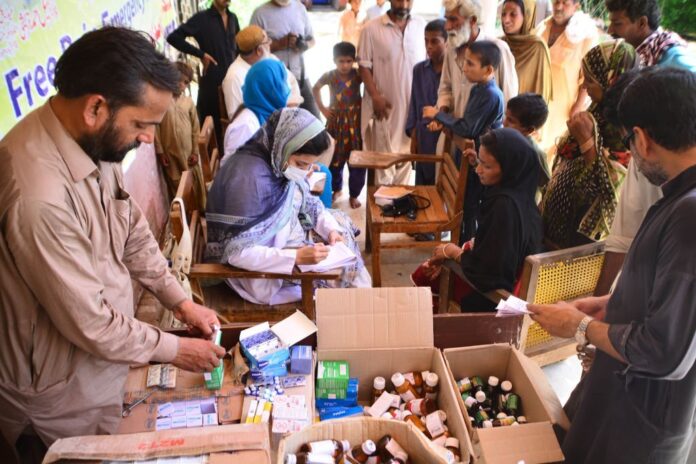By Dr Ghulam Mohey-ud-din
Pakistan’s overburdened healthcare system can provide better relief to the people through the implementation of certain targeted measures and streamlining of services. The healthcare system in its current form is a hybrid of public and private healthcare providers. Spending on healthcare is roughly around 3 percent of GDP, with the share of public sector healthcare spending at 1.2 percent of GDP.
There is a lopsided reliance on the private sector, which is evident through the out-of-pocket (OOP) expenditure on health, which is more than 60 percent in Pakistan. The private sector is generally unregulated and serves the urban, and the relatively wealthy segments of society. There is rampant price gouging, but little to show for it in terms of quality. There are several dysfunctional areas of the healthcare system that can be optimised to redistribute the burden on existing facilities for the benefit of the people.
The National Security Policy (NSP) 2022 identifies health security as an important constituent of “human security,” a key pillar of economic security. Furthermore, the COVID-19 pandemic significantly raised the prominence of health as a national security concern. The NSP-2022 reiterates Pakistan’s pledge to address the lack of quality health facilities and highlights the need to invest in preventive, curative, and public health ecosystems.
The government primarily funds the public sector, which offers free or subsidised services to the general public. However, the public sector is beset by numerous challenges including inadequate funding, poor infrastructure, insufficient human resources, poor governance, and poor service delivery. In addition, one of the major flaws of the public sector is that the public health infrastructure is based around administrative boundaries instead of international standards of beds-to-population ratio, doctors-to-population ratio, etc.
Pakistan’s health infrastructure is organised into primary, secondary, and tertiary levels. Primary-level health infrastructure comprises basic health units (BHUs), dispensaries, and filter clinics. In addition, vaccinations, immunisations, and mother and child health (MCH)-related services are also provided through lady health workers (LHW) and lady health visitors (LHVs). The secondary-level services are offered by tehsil headquarter hospitals (THQs) and district headquarter hospitals (DHQs). In addition, RHCs (rural health centres) also offer limited secondary-level services with 20 medical beds along with primary or basic services. The tertiary-level services comprise specialised medical care and medical education.
In the existing system, each tehsil headquarters is allocated one THQ and each district headquarter one DHQ, irrespective of population and geographic spread. The number of beds in THQs and DHQs is based to some extent on the population differentials among districts and tehsils. However, the major dilemma of the existing system is that rural blocks or union councils have at the very least BHUs for offering basic healthcare services. On the other hand, cities and urban centres like tehsil and district headquarters primarily rely on THQs or DHQs with an insufficient number of dispensaries or filter clinics operated by the local government. Their ownership is also a problem, as some of these dispensaries and clinics have been transferred to the health department but still lack funds and oversight.
In addition to providing primary services to the existing urban population of that city, the THQs and DHQs also have to deal with an influx of referral patients from rural areas of the entire surrounding tehsil and district. The under-privileged urban population overwhelms the facilities at these hospitals for primary healthcare needs like fevers, minor illnesses, seasonal flu, etc., whereas the middle class falls back on low-quality private clinics, general practitioners (GPs), quacks, and hakeems for healthcare needs. The well-off segments of society go for costly private healthcare service providers, specialists, and consultants.
Another problem related to primary urban healthcare is the upgrading of tehsils into districts, which also results in the administrative upgrading of a THQ into a DHQ. The construction of new blocks and provision of additional beds takes time, but the existing poorly equipped THQ suddenly has to deal with the burden of an entire tehsil along with the provision of primary services to the urban centre. Similarly, upgrading DHQs into specialised and teaching hospitals also results in overburdening the existing facilities by requiring the provision of primary, secondary, and tertiary healthcare and teaching facilities from such facilities.
Another linked issue is that LHWs and LHVs offering immunisation and mother and child health (MCH) services door-to-door have limited space in BHUs in rural areas where they can offer their services in addition to carrying out field visits and hosting vaccination storage facilities. However, the LHWs and LHVs operating in urban areas do not have such facilities, as there is no provision for BHUs in urban areas, despite the fact that they deal with reasonably large and dense populations. Thus, people in urban areas cannot go for vaccination in nearby areas if their area or house is missed during the visit of an LHV or LHW.
The above-stated issues underscore the need to revamp Pakistan’s healthcare ecosystem based on WHO standards and SDGs, ensuring better access and service delivery. Furthermore, there is also a dire need to establish additional basic healthcare units, urban dispensaries, or clinics in each block and locality of urban areas and cities. This will improve the provision of basic health facilities as well as decrease pressure on secondary and tertiary-level facilities and hospitals. Addressing this missing link in the existing urban health ecosystem will help ensure better utilisation of resources and improve accessibility and quality of services for the people.
The author is Director Economic Affairs at the Centre for Aerospace & Security Studies (CASS), Lahore, Pakistan. He can be reached at [email protected]


















